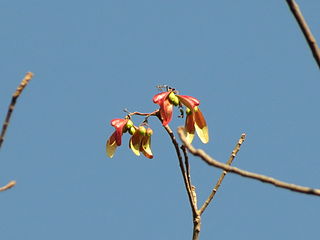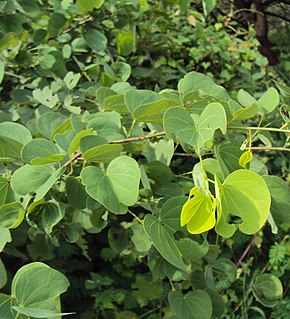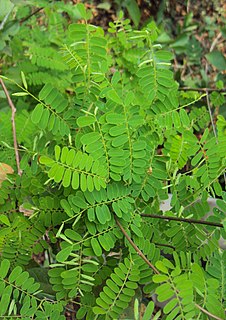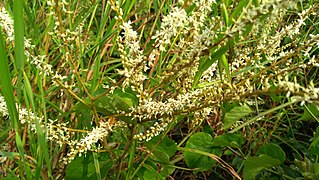
A savanna or savannah is a mixed woodland-grassland ecosystem characterised by the trees being sufficiently widely spaced so that the canopy does not close. The open canopy allows sufficient light to reach the ground to support an unbroken herbaceous layer consisting primarily of grasses.

Astragalus tragacantha, commonly known as astragale de Marseille or coussin-de-belle-mère, is a species of milkvetch in the family Fabaceae. The plant is about 10 to 25 cm in height with white, purple tinged flowers that bloom in April and March. Tragacantha grows in sandy soil around beaches and is native to France, Spain, and the Mediterranean.

Psoralea argophylla is a species of legume in the family Fabaceae. The species is native to the central United States, as well as the three Canadian prairie provinces, Alberta, Saskatchewan, and Manitoba. Psoralea argophylla grows naturally on forb, and it grows perennially.

Pterocymbium is a genus in the family Malvaceae: in the subfamily Sterculioideae and previously placed in the Sterculiaceae. In Indonesia, P. tinctorium (Kelumbuk) is a significant timber tree.

Entada phaseoloides commonly named the "box bean" or "St. Thomas’ bean", first described by Linnaeus, with its current name described by Merrill. E. phaseoloides is a liana in the pea family: called Gugo, Balugo or Tamayan in the Philippines and Bàm bàm in Viet Nam. No subspecies are listed in the Catalogue of Life.

Anisoptera thurifera is a tree species in the family Dipterocarpaceae. This Asian species has been recorded from Bangladesh through to New Guinea; the IUCN has categorised it as Vulnerable.

Piliostigma malabaricum is a small tree species in the family Fabaceae. It was previously placed in the genus Bauhinia, but names changed with reorganisation of the subfamily Cercidoideae and the tribe Bauhinieae.

Dalbergia horrida is a species of thorny liana, with the Vietnamese name trắc nhiều hoa which is in the subfamily Faboideae and tribe Dalbergieae.
Dalbergia candenatensis is a species of liana, with the Vietnamese name trắc một hột. It is now placed in the subfamily Faboideae and tribe Dalbergieae; no subspecies are listed in the Catalogue of Life.
Dalbergia spinosa is a species of thorny liana, with the Vietnamese name trắc gai. The genus Dalbergia is placed in the subfamily Faboideae and tribe Dalbergieae; no subspecies are listed in the Catalogue of Life.
Dalbergia rimosa is a species of liana, with the Vietnamese name trắc giây or trắc dây. The genus Dalbergia is placed in the subfamily Faboideae and tribe Dalbergieae.
Dalbergia stipulacea is a species of small tree, with the Vietnamese name trắc lá bẹ. The genus Dalbergia is placed in the subfamily Faboideae and tribe Dalbergieae.

Lasiobema scandens is a species of 'monkey ladder' lianas in the subfamily Cercidoideae and the tribe Bauhinieae, the genus having been separated from Bauhinia but possibly synonymous with Phanera. Under its synonym, Bauhinia scandens, records exist from the Indian subcontinent, Indo-China and Malesia. The Catalogue of Life listed two varieties which remain valid:

Phrynium pubinerve is the type species of the plant genus Phrynium, in the family Marantaceae. It is widespread throughout Asia, with records from India, China, and Indo-China through to New Guinea; no subspecies are listed in the Catalogue of Life.

Wrightia pubescens is a species of small tree in the family Apocynaceae. Its distribution includes: Australia, southern China, Taiwan (introduced), Indonesia, New Guinea, Philippines and Indo-China. In Viet Nam, it may be called: lòng mức lông.
Uncaria acida is a species of liana in the family Rubiaceae.

Ficus fistulosa is an Asian species of fig tree in the family Moraceae. No subspecies are listed in the Catalogue of Life; its native range is Assam to Taiwan, Indo-China, Malesia and New Guinea. The species can be found in Vietnam: where it may be called sung giòn.

Artocarpus nitidus is a tree in the family Moraceae and a wild species on the breadfruit/jackfruit genus (Artocarpus); it may be referred-to as the butong in Tagalog and its Vietnamese name is mít nhỏ. Distribution records are from: China, Indo-China and Malesia through to New Guinea.

Ficus subcordata is a banyan fig species in the family Moraceae. No subspecies are listed in the Catalogue of Life. The species can be found in Indo-china, Malesia and New Guinea. In Vietnam it may be called sung mù u.

Schistocerca pallens is a large “bird grasshopper” in the subfamily Cyrtacanthacridinae that occurs throughout tropical America. It is closely related to Schistocerca cancellata but shows no swarming behaviour or locust phase polymorphism, even under crowded laboratory conditions. Although not a swarming locust, it can occur at sufficiently high densities to cause economic damage. It is mainly a pest of sugar cane, but has also been recorded as damaging almond, banana, beans, breadfruit, carnauba wax palm, chickpeas, coconut palms, cotton, forage crops, groundnuts, indigo, legumes, maize, onions, rice, sorghum, sweet potato and tomatoes.














